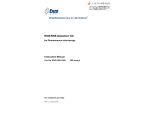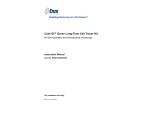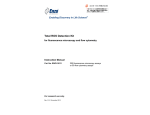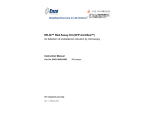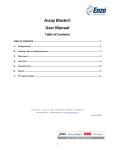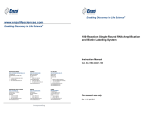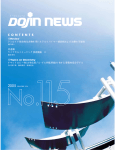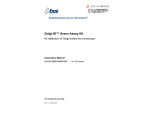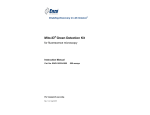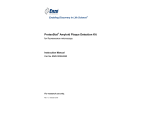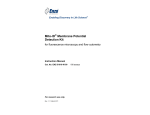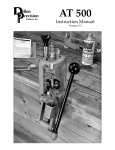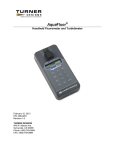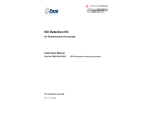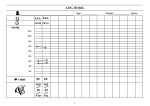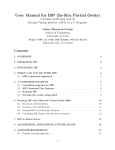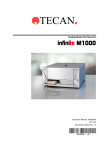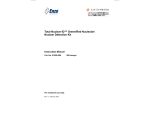Download User Manual-ENZ-51023-KP002
Transcript
※本プロトコールは参考用の資料になり ます。商品ご購入の際は必ず商品に添付 されている資料をご参照ください。 Enabling Discovery in Life Science® ProteoStat® Protein Aggregation Assay for microplates Instruction Manual Cat. No. ENZ-51023-KP002 For research use only. Rev. 1.5.0 August 2011 for 2 x 96-well plates Notice to Purchaser This product is manufactured and sold by ENZO LIFE SCIENCES, INC. for research use only by the end-user in the research market and is not intended for diagnostic or therapeutic use. Purchase does not include any right or license to use, develop or otherwise exploit this product commercially. Any commercial use, development or exploitation of this product or development using this product without the express prior written authorization of ENZO LIFE SCIENCES, INC. is strictly prohibited. Limited Warranty These products are offered under a limited warranty. The products are guaranteed to meet appropriate specifications described in the package insert at the time of shipment. Enzo Life Sciences’ sole obligation is to replace the product to the extent of the purchase price. All claims must be made to Enzo Life Sciences, Inc. within five (5) days of receipt of order. Trademarks and Patents Enzo and ProteoStat are trademarks of Enzo Life Sciences, Inc. Grenier is a registered trademark of Grenier Bio-One. Several of Enzo’s products and product applications are covered by US and foreign patents and patents pending. Contents I. Introduction ............................................................... 1 II. Reagents Provided and Storage.............................. 1 III. Additional Materials Required ................................. 2 IV. Safety Warnings and Precautions........................... 2 V. Methods and Procedures ......................................... 2 A. REAGENT PREPARATION ................................................... 2 B. STAINING ........................................................................ 3 C. CREATING A STANDARD CURVE ........................................ 4 VI. Appendices ............................................................... 5 A. MICROPLATE SETTING SELECTION ................................... 5 B. EXPECTED RESULTS ....................................................... 5 C. REAGENT COMPATABILITY WITH ASSAY ............................ 8 VII. References .............................................................. 10 VIII. Troubleshooting Guide ......................................... 11 I. Introduction Biochemical and biophysical assays for monitoring protein aggregation are often cumbersome, relying upon ultracentrifugation, size-exclusion chromatography, gel electrophoresis, dynamic light scattering, or turbidity measurements.1,4 None of the above mentioned techniques works well for every protein, nor are the assays ideal for tackling the wide range of aggregation problems that can arise during the manufacture of protein pharmaceuticals. Enzo Life Sciences’ ProteoStat® Protein Aggregation Assay provides a simple, homogenous assay format for monitoring peptide and protein aggregation. The assay can be employed to streamline protein processing and formulation optimization procedures. Relative to conventional protein aggregation detection dyes, such as Thioflavin T, Enzo’s ProteoStat® Detection Reagent can detect aggregates from a broader range of proteins, yields a much brighter signal, provides at least 2 orders of magnitude linear dynamic range and offers superior performance across a broad range of pH values (4~10) and buffer compositions. Sensitivity of this assay is in the submicromolar range and less than 1% protein aggregate is detectable in a protein solution. The assay provides a convenient mix and read format and delivers Z’ factor scores greater than 0.5. Therefore, the assay is capable of providing quantitative analysis of protein aggregation in a robust and high-throughput fashion. Lyophilized native and aggregated lysozyme is provided as negative and positive controls for monitoring changes in protein aggregation status. To facilitate quantitative analysis of protein aggregation, The ProteoStat® Protein Aggregation standards (ENZ-51039) can be used to determine low levels of aggregated protein in a sample by comparing the assay response of a test sample to that of the standard curve; comprised of standards with known concentrations of aggregated IgG. The ProteoStat® Protein Aggregation Assay enables monitoring of protein aggregate formation in solution. This is useful for defining optimal storage formulations for proteins, for screening of compounds that promote or inhibit protein aggregation and, potentially, for the sensitive measurement of molecular chaperone activity. II. Reagents Provided and Storage Reagent Quantity ® 22 µL ® 300 µg (lyophilized lysozyme) ® 300 µg (lyophilized lysozyme) ProteoStat Detection Reagent ProteoStat Positive Control, Aggregate ProteoStat Negative Control, Monomer ® 15 mL 10X ProteoStat Assay Buffer 1 All reagents are shipped on dry ice. Upon receipt, the kit should be stored upright and protected from light at ≤-20°C. When stored properly, these reagents are stable for at least twelve months. Avoid repeated freezing and thawing. The reagents provided in the kit are sufficient for 2 x 96-well microplates. III. Additional Materials Required • Fluorescence microplate reader with a filter set or monochromator setting of Excitation = ~550 nm / Emission = ~600 nm. • 96 -well microplate: black wall microplate, preferably with a clear bottom. • Calibrated, adjustable precision pipetters, preferably with disposable plastic tips. • Deionized water. IV. Safety Warnings and Precautions • This product is for research use only and is not intended for diagnostic purposes. • Some components of this kit may contain hazardous substances. Reagents can be harmful if ingested or absorbed through the skin and may cause irritation to the eyes. Reagents should be treated as possible mutagens and should be handled with care and disposed of properly. • Observe good laboratory practices. Gloves, lab coat, and protective eyewear should always be worn. Never pipet by mouth. Do not eat, drink or smoke in the laboratory areas. All blood components and biological materials should be treated as potentially hazardous and handled as such. They should be disposed of in accordance with established safety procedures. • To avoid photobleaching, perform all manipulations in low light environments, in amber microcentrifuge tubes or protected from light by other means. V. Methods and Procedures A. REAGENT PREPARATION NOTE: Allow all reagents to thaw at room temperature before beginning the procedures. Upon thawing, gently hand-mix or vortex the reagents prior to use to ensure a homogenous solution. Briefly centrifuge the vials at the time of first use, to gather the contents at the bottom of the tube. 2 1. 10X Assay Buffer Allow the 10X ProteoStat® Assay Buffer to warm to room temperature. Make sure that the reagent is free of any crystallization. 2. Controls Prepare the ProteoStat® Positive Control (Aggregate) and the ProteoStat® Negative Control (Monomer) for monitoring and detection of protein aggregation. Both controls are supplied as lyophilized powder (300 µg each) and should be reconstituted in 500 μL deionized water to generate a 40 µM stock solution. Gently mix the controls to re-suspend them—do not vortex or cause unnecessary bubbles. It is strongly recommended to perform the assay with positive (20 µM aggregated Lysozyme) and negative control (20 µM native Lysozyme). Unused stock control samples may be stored in aliquots at 4°C for several weeks. Do not centrifuge the positive control, as the aggregates are in suspension, not in solution. 3. ProteoStat® Detection Reagent Loading Solution NOTE: The ProteoStat® Detection Reagent is light sensitive. Avoid direct exposure of the reagent to intense light. Aliquot and store unused reagent at –20°C, protected from light. Avoid repeated freeze/thaw cycles. For each 96-well plate, prepare 200 µL of ProteoStat® Detection Reagent Loading Solution as follows: Add 10 µL of ProteoStat® Detection Reagent and 20 µL of 10X Assay Buffer into 170 µL deionized water. Mix well. B. STAINING 1. Dispense 2 µL of the prepared ProteoStat® Detection Reagent Loading Solution (see section A-3, page 3) into the bottom of each well of a 96-well microplate. NOTE: The ProteoStat® detection dye is light sensitive. Be sure to protect samples from light. 2. Add 98 µL of the protein of interest to each well. The recommended protein concentration range is 1 µg/ml to 10 mg/ ml. For higher concentrations of protein (mg/ml range), fluorescence intensity readings in the presence of high amounts of aggregate may become saturated and beyond the linear range of the assay. This should not be a problem when detecting lower aggregation levels (<20% aggregated protein). If desired, higher concentrations of protein may be diluted in 1X Assay Buffer or buffer of interest prior to assaying for protein aggregation. The final concentration of the ProteoStat® detection dye is about 3 µM in the assay. 3 Be certain to run negative and positive control samples, as well as 1X Assay Buffer alone (no protein), as a blank sample. 3. Incubate the microplate containing test samples in the dark for 15 minutes at room temperature. 4. Read generated signal with a fluorescence microplate reader using an excitation setting of about 550 nm and an emission filter of about 600 nm. NOTE: DO NOT wash the sample after incubation with ProteoStat® detection dye. The fluorescence value of 1X Assay Buffer alone should be subtracted from the values for wells containing proteins. C. CREATING A STANDARD CURVE The ProteoStat® Protein Aggregation Assay can be used to determine the percentage aggregated protein in a sample by comparing the assay response of a sample to that of a standard whose concentration is known. For convenience, Enzo Life Sciences offers preformulated aggregation standards (ENZ-51039). The stabilized, highquality reference samples allow easy generation of trace protein aggregate levels in concentrated monomeric IgG. However, it is also possible to prepare standards directly in the laboratory. Regardless, protein samples and protein aggregation standards should be analyzed in the same manner by mixing them with detection reagent and using a fluorescence microplate reader to measure the intensity values. As with any protein assay, different protein aggregates will elicit greater or lesser fluorescence intensity response based upon their inherent amino acid composition and sequence. It is recommended that a standard curve be prepared each time the assay is performed. For best results, the protein aggregation standard should always be prepared in the same buffer as the sample. The best choice for a standard is a highly purified version of the aggregated protein being analyzed in the test samples. If a highly purified version of the protein of interest is not available or if it is too expensive to use as the standard, the alternative is to choose a protein that will produce a similar fluorescence response curve with the ProteoStat® Protein Aggregation Assay. For example, when analyzing IgG aggregation, an inexpensive goat anti-mouse antibody may be substituted for generating the standard curve. Once the standard protein is selected, it is necessary to generate a fully aggregated form of it. This is typically achieved by thermal denaturation as described below. 1. Create a fully aggregated standard protein. This is typically performed by heating the protein with shaking in a buffer that promotes aggregation of the protein. For example, an IgG antibody should be diluted to 0.9 mg/mL in 100 mM HCl and incubated at 37°C overnight. 2. Monitor the aggregation process using the ProteoStat® dye assay method described in section B at different time points. In the 4 example given in Figure 1, different stages are generally observed during the formation of IgG protein aggregates. First, a lag time is observed during which no aggregates are formed. After a certain lag time, nucleation occurs, and aggregates start to form (growth phase). Eventually, the growth rate decreases and becomes zero, indicating a limitation in monomer supply. The protein is considered fully aggregated when the fluorescence intensity no longer increases. Continued incubation may lead to large insoluble aggregates. For this reason it is best to employ the fully aggregated protein as soon as it reaches the plateau phase for further use. 3. The standard curve is generated from different concentrations of aggregated protein in monomeric protein. The protein concentration used is typically about 30 µM, but this may vary significantly, depending upon the needs of the investigator. A typical curve can be created using 100%, 80%, 40%, 20%, 10%, 5%, 2.5%, 1.25%, 0.6%, 0.3% and 0% aggregated protein. The different solutions of aggregated protein are prepared by mixing different ratios of aggregated protein and monomeric protein, keeping the total protein concentration the same. For example, a 20% aggregated protein can be prepared by adding 10 uL of 100% aggregated protein and 40 uL of monomeric protein to each well. A 10% aggregated protein can be prepared by mixing 5 µL of 100% aggregated protein and 45 µL of monomeric protein in a well. See Figure 3 and Table 1. Typically, standard curves are constructed using at least three replicates for each point on the curve. VI. APPENDICES A. MICROPLATE SETTING SELECTION The selection of optimal settings for a fluorescence microplate reader application requires matching the monochromator or optical filter specifications to the spectral characteristics of the dyes employed in the analysis. Please consult your instrument or filter set manufacturer for assistance in selecting optimal filter sets. Pre-designed filter sets for Texas Red should work well for this application. For monochromator-based detection, we recommend a slit width of approximately 9 nm. Excitation around 550 nm gives slightly higher signal for protein aggregates relative to properly folded monomeric protein. B. EXPECTED RESULTS The formulation of protein drugs is a difficult and time consuming process, mainly due to the structural complexity of proteins and the very specific physical and chemical properties they possess. Most protein formulations contain excipients added to stabilize protein structure, such as a particular buffer system, isotonic substances, metal ions, preservatives and one or more surfactants, with various 5 concentration ranges to be tested. The conventional instrumentationintensive analytical methods are intrinsically low-throughput, and usually require a long period of time to perform, as well as many manual interventions during the evaluation period. The development of new formulations is costly in terms of time and resources. Moreover, even for a known protein formulation, batch to batch quality control analysis is often less than optimal using the current state of the art methods. Therefore, a versatile, reliable, rapid and resource-efficient analytical method is useful for both developing novel protein formulations and identifying protein stability in quality control procedures. Protein aggregates are characterized by a cross-beta spine quaternary structure.5 In this structure beta strands of stacked beta sheets, emanating from different protein monomers, are aligned perpendicular to the axis of the fibril. The resulting quaternary structure consists of a double beta sheet, with each sheet formed from parallel segments stacked in register. Side chains protruding from the two sheets form a dry, tightly self-complementing steric zipper, bonding the sheets together. Within each sheet, every segment is bound to its two neighboring segments through stacks of both backbone and sidechain hydrogen bonds. The structure highlights the overall stability of amyloid fibrils, their self-seeding characteristics and their tendency to form polymorphic structures. The ProteoStat® Protein Aggregation Assay kit contains a proprietary fluorescent probe that is minimally 100 90 80 70 Growth Phase Aggregate Signal Lag Phase 60 Plateau Phase Region is considered 100% aggregated. 50 40 30 20 10 0 0 hrs 6 hrs 12 hrs Time 18 hrs 24 hrs Figure 1. Different stages are generally observed during the formation of IgG protein aggregates. First, a lag time is observed during which no fibrils are formed. Then, nucleation occurs, and fibrils start to form (growth phase). Eventually, the growth rate decreases and becomes zero, indicating a limitation in native protein supply. The aggregation process can be accelerated by subjecting the proteins to elevated temperature. Extensive aggregation will cause large insoluble aggregates. 6 fluorescent in the presence of the native form of a protein, but displays a 20~90-fold fluorescence intensity enhancement upon binding to the cross-beta spine quaternary structure of aggregated proteins. Figure 3 demonstrates the linear dynamic range of detection for goat anti-mouse IgG aggregate using ProteoStat® Detection Reagent, as compared with Thioflavin T. Purified rabbit anti-goat IgG (4.26 mg/ mL) was incubated in 100 mM HCl, pH 2.7, at 80°C for 90 minutes to form aggregates. The signal from the aggregate was determined after mixing aggregated with monomeric proteins at different ratios, such that the total IgG concentration remained 60 µg/mL protein. The readings were taken in 50 mM potassium phosphate, pH 7, containing either 3 µM ProteoStat® reagent or 3 µM Thioflavin T. Protein 1 0.9 0.8 0.7 0.6 0.5 0.4 0.3 0.2 0.1 0 400 450 500 550 600 650 700 Figure 2. Absorption and fluorescence emission spectra for ProteoStat® Detection Reagent. All spectra were determined in 1X Assay Buffer. was incubated with the dye for 15 minutes prior to determining the fluorescence using a BioTek Synergy Mx microplate reader, with excitation setting at 500 nm and emission setting at 603 nm, both with a 9 nm slit-width for ProteoStat® reagent, while Thioflavin T was detected with excitation setting at 435 nm and emission setting at 495 nm, both with a 9 nm slit-width. Readings were taken in at least triplicate in a Greiner® µClear black, clear bottom 96-well microplate. As demonstrated in Figure 3, the signal generated from the ProteoStat® Detection Reagent is ~100-fold brighter than Thioflavin T, and the concentration response curve is more linear. In Table 1, the limit of antibody aggregate detection using ProteoStat® Detection Reagent compared with Thioflavin T is shown. ProteoStat® Detection Reagent is able to reliably detect as little as 0.3% aggregated IgG in concentrated IgG sample (i.e., 0.19 µg/mL of the 60 µg/ mL total IgG concentration). Thus, the kit provides an ideal analytical method enabling sensitive, accurate, and linear detection of protein aggregates over a broad concentration range. Additionally, the assay is resistant to sample7 matrix interference and compatible with high throughput screening workflows. Figure 3. Effective linear dynamic range for antibody aggregate detection using ProteoStat® Detection Reagent compared with Thioflavin T. Relative fluorescence unit values (RFUs) may differ depending upon the microplate reader employed for the analysis. C. REAGENT COMPATIBILITY WITH ASSAY The following table summarizes a sampling of reagents and their concentrations that have been demonstrated to be compatible with the ProteoStat® Protein Aggregation Assay. The values represent the highest concentration of reagent tested with the protein sample. Reagents were tested individually in the protein samples and were Table 1. Detection limit comparison between ProteoStat® Detection Reagent Thioflavin T. 8 and considered compatible if the monomer signal didn’t increase by more than 2-fold. This information is only provided as a guideline and actual samples, which normally contain different buffers and other components, may behave differently. Tested Reagents and Validated Concentrations Sodium Chloride, up to 1 M Ascorbic Acid, up to 1 mM Calcium Chloride, up to 200 mM Dithiothreitol, up to 1 mM Ammonium Sulfate, up to 300 mM Triton X-100, up to 0.01%* Sorbitol, up to 600 mM Tween-20 up to 0.01%* Mannitol, up to 600 mM Arginine, up to 500 mM Trehalose, up to 600 mM Glycine, up to 2% Lactose, up to 300 mM Ethanol, up to 20% *Higher concentrations of certain detergents, such as 0.2% Tween-20, may produce an increase in background signal with the monomeric protein. However, the protein aggregate signal typically remains substantially larger. Table 2. Substances tested for compatibility with the ProteoStat® Protein Aggregation Assay. 9 VII. References 1. Arakawa T, Philo JS, Ejima D, Tsumoto K, Arisaka F (2006), "Aggregation analysis of therapeutic proteins, part 1". Bioprocess International 4 (10) : 32-42) 2. Krishnamurthy R, Sukumar M, Das TK, Lacher NA (2008), "Emerging analytical technologies for biothererapeutics development". Bioprocess International 6 (5) : 32-42) 3. Arakawa T, Philo JS, Ejima D, Tsumoto K, Arisaka F (2007), "Aggregation analysis of therapeutic proteins, part 2". Bioprocess International 5 (4) : 36-47) 4. Arakawa T, Philo JS, Ejima D, Sato H, Tsumoto K (2007), "Aggregation analysis of therapeutic proteins, part 3". Bioprocess International 5 (10) : 52-70 5. Nelson R, Sawaya MR, Balbirnie M, Madsen AØ, Riekel C, Grothe R, Eisenberg D. (2005) “Structure of the cross-beta spine of amyloid-like fibrils.” Nature. 2005 435(7043):773-778. 10 VIII. Troubleshooting Guide Problem Poor fluorescent signal observed in the positive control High fluorescence background in the well without protein sample Protein signal is saturated. Potential Cause Suggestion Detection reagent has been exposed to strong light. Protect samples from exposure to strong light and analyze them immediately after staining. Kit reagent has degraded. Verify that the reagents are not past their expiration dates before using them. Band pass settings are too narrow or not optimal for the fluorescent probe. Use correct monochromator setting or filter set for the fluorophore. Check Methods and Procedures section of this manual and Appendix A for recommendations. Insufficient ProteoStat® dye concentration Follow the procedures provided in this manual. The aggregated protein is not in solution. Extended centrifugation will cause the aggregate to precipitate Do not centrifuge the aggregated protein (sample or control). Inappropriate dye dilution Follow the procedures provided in this manual. It is important to make certain that there are no particles in the dye. Centrifuge well before use. Dust or solid material in well Make certain all solutions, micro -plates and tubes are clean and free of dust and dirt. The concentration from protein sample is too high. Dilute the sample further with 1X Assay Buffer. High fluorescence signal Sample contains interfering observed in negative substances. control The assay is compatible with commonly used buffers (PBS, Tris, HEPES) and excipients (trehalose and sucrose), but not with high concentration of Tween 20 (e.g., >0.2%) There is no apparent protein in the controls. Resuspend the protein as recommended. Sometimes, the dried protein is difficult to see. 11 www.enzolifesciences.com Enabling Discovery in Life Science® NORTH/SOUTH NORTH/SOUTH AMERICA AMERICA GERMANY UK & IRELAND ENZO LIFE SCIENCES INTERNATIONAL, INC. ENZO LIFE SCIENCES INTERNATIONAL, 10 Executive Boulevard INC. Farmingdale, NY 11735-4710 5120 Butler Pike USA Plymouth Meeting, PA 19462-1202 T 1-800-942-0430/(631) 694-7070 USA F (631) 694-7501 T 1-800-942-0430/(610) 941-0430 E [email protected] F (610) 941-9252 www.enzolifesciences.com ENZO LIFE SCIENCES GMBH Marie-Curie-Strasse 8 DE-79539 Lörrach Germany T +49/0 7621 5500 526 Toll Free 0800 664 9518 F +49/0 7621 5500 527 E [email protected] www.enzolifesciences.com ENZO LIFE SCIENCES (UK) LTD. Palatine House Matford Court Exeter EX2 8NL UK T 0845 601 1488 (UK customers) T +44/0 1392 825900 (from overseas) F +44/0 1392 825910 E [email protected] www.enzolifesciences.com SWITZERLAND & REST OF EUROPE BENELUX FRANCE ENZO LIFE SCIENCES AG Industriestrasse 17, Postfach CH-4415 Lausen Switzerland T +41/0 61 926 89 89 F +41/0 61 926 89 79 E [email protected] www.enzolifesciences.com ENZO LIFE SCIENCES BVBA Frankrijklei 33 BE-2000 Antwerpen, Belgium T +32/0 3 466 04 20 F +33/0 437 484 239 E [email protected] www.enzolifesciences.com ENZO LIFE SCIENCES c/o Covalab s.a.s. 13, Avenue Albert Einstein FR -69100 Villeurbanne France T +33 472 440 655 F +33 437 484 239 E [email protected] www.enzolifesciences.com

















